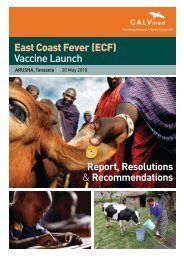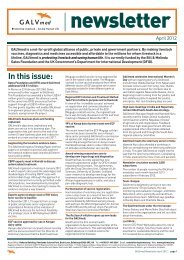A Path to Prosperity New Directions for African Livestock
GALVmed Impetus Strategy Paper
GALVmed Impetus Strategy Paper
- No tags were found...
Create successful ePaper yourself
Turn your PDF publications into a flip-book with our unique Google optimized e-Paper software.
6.3 Contract Farming<br />
In<strong>for</strong>mal, traditional markets <strong>for</strong> lives<strong>to</strong>ck products<br />
are still dominant in most of SSA. For example, 90%<br />
of Ghana’s beef supply is channelled through the<br />
in<strong>for</strong>mal markets. Smallholders can compete in<br />
in<strong>for</strong>mal or ‘spot’ markets because they have lower<br />
quality standards and the markets don’t depend on<br />
regular supply from a given producer. However, rising<br />
incomes and expectations of urban consumers<br />
promote more sophisticated and <strong>for</strong>mal market<br />
arrangements. This is symbolised by the growth of<br />
supermarkets across the developing world. Though<br />
Africa lags behind other regions, supermarkets and<br />
the value chains they represent are slowly becoming<br />
a reality. In the early 2000s, supermarkets had<br />
50–60% of the market in Latin America, 10–30% in<br />
S.E. Asia and increasing market share in eastern and<br />
southern Africa. In Kenya, <strong>for</strong> example, they had a<br />
20% share of the processed food market 127 . These<br />
figures are now probably higher.<br />
As markets develop they expect four key requirements<br />
that all involve higher costs per unit of product <strong>for</strong><br />
small farmers and potentially allow larger<br />
producers <strong>to</strong> capture the market. These are:<br />
> Quality and safety standards, which often<br />
require on-farm investments;<br />
> Uni<strong>for</strong>mity of the product, requiring investments<br />
in breeding, feeding, and veterinary health;<br />
> Reliability of supply, which requires product<br />
specialization and/or higher level of production; and<br />
> Verifiability of origin, which requires traceability<br />
systems 128 .<br />
Of course, not all small farmers will be able <strong>to</strong><br />
meet the requirements of a <strong>for</strong>malised market and<br />
will either drop out of farming or continue supplying<br />
in<strong>for</strong>mal local markets. In Brazil in the 1990s<br />
supermarketisation was directly linked <strong>to</strong> the exit of<br />
small dairy farmers. Sixty thousand farmers ceased<br />
production in ten years and the average farm size<br />
increased by 55%, with similar patterns in Argentina<br />
and Chile 129 . Whilst Africa is still a long way from<br />
value chains being dominated by supermarkets,<br />
policy makers and agri-business do need <strong>to</strong><br />
determine how <strong>to</strong> assist those small farmers who<br />
are willing and capable of meeting higher standards<br />
and how <strong>to</strong> create the jobs <strong>for</strong> those who are not.<br />
Experience from the horticultural sec<strong>to</strong>r suggests<br />
small <strong>African</strong> farmers are able <strong>to</strong> meet higher<br />
standards and thrive when supported <strong>to</strong> do so.<br />
The three ways <strong>for</strong> supporting small farmers<br />
commonly cited are first, strengthening cooperative<br />
action between farmers, secondly, contract farming<br />
and thirdly, strengthening farmers associations.<br />
Cooperative farming systems can be very successful.<br />
For example: the National Dairy Development Board<br />
in India; Fonterra, the world's largest exporter of<br />
dairy products and owned by 13000 <strong>New</strong> Zealand<br />
dairy farmers; Land O’Lakes, the USA’s second<br />
largest cooperative serving 300,000 farmers and the<br />
Development Foundation of Turkey (TKV) working<br />
with 2500 broiler producers. However, these tend <strong>to</strong><br />
be exceptions. Most cooperatives are unable <strong>to</strong><br />
compete with private companies 130 and their<br />
establishment is both complex and relatively slow.<br />
Contract farming appears <strong>to</strong> offer more potential and<br />
there is evidence <strong>to</strong> suggest that in the developing<br />
world contract farmers have, in most cases, higher<br />
profits per unit of output than independent farmers<br />
(both large and small). Contract farming can<br />
incorporate smallholders in high-value supply chains<br />
that require specialized inputs and sell <strong>to</strong> markets<br />
<strong>for</strong> specialized outputs. The three main types of<br />
contract farming have been described by Minot 131 as:<br />
1 Market-specification contracts – where the<br />
contract involves an exchange of technical and<br />
market in<strong>for</strong>mation about the product quality<br />
required, timing and prices <strong>for</strong> specified markets.<br />
2 Management-providing contracts – where the<br />
farmer is assisted in terms of least-cost<br />
production practices <strong>to</strong> attain higher quality and<br />
control the timing of output. The contrac<strong>to</strong>r<br />
recoups the costs of extension provided from the<br />
proceeds of marketing a higher-quality product.<br />
3 Resource-providing contracts – where credit,<br />
inputs and/or agricultural services are provided<br />
by the contrac<strong>to</strong>r who then recoups outlay<br />
through marketing of the product.<br />
Which type of contract is needed will vary by value<br />
chain and depend upon the circumstances of the<br />
farmers. While vertically integrated systems that<br />
depend on contracts sound like an excellent solution<br />
<strong>to</strong> improving market access and the capacity of small<br />
lives<strong>to</strong>ck farmers, there are un<strong>for</strong>tunately very few<br />
examples of them functioning in SSA. (Box 7 provides<br />
some examples of successful contract farming<br />
arrangements). This lack of examples is perhaps<br />
related <strong>to</strong> the fact that contract farming requires<br />
effective en<strong>for</strong>cement of a clear legal framework and<br />
this is a problem in many SSA countries. Interestingly,<br />
contract farming is the norm in the developed world<br />
<strong>for</strong> poultry and pork value chains. How <strong>to</strong> develop<br />
contract farming operations in SSA is a key challenge.<br />
The Impetus Strategy Paper I Page 45











